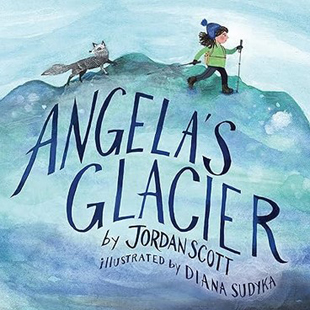Nothing is stronger than reverent love when it comes to protecting the natural world. When we revere forests, we become good stewards of their unique ecosystems. When we cherish elephants, we look for ways to protect them.
Glaciers, too, we know, are critical to care about. On January 21, 2024, The New York Times reported that "In the past two years alone, Swiss glaciers have lost 10 percent of their water volume — as much as melted in the three decades from 1960 to 1990." But how do children who don't live close to glaciers come to fall in love with them in ways that will make a difference?
With gentle power, Angela's Glacier fills this gap. Shortly after Angela is born, the clouds lift from the nearby glacier, revealing its "peacock, indigo, and duck-egg blue" colors. Angela's father bundles her up, takes her out to look, and promises to take her there. Before she even learns to walk, he hikes with her to the glacier and allows her to listen to it and touch it. He teaches her its name by aligning the syllables with his steps: Snae - fells - jö - kull.
It's not long before Angela is visiting Snaefellsjökull on her own. Illustrator Diana Sudyka shows Angela lying on the glacier's surface, hugging it, her black snowsuit sparkling with snowflakes in such a way that it looks as if she's dressed in a star-spangled galaxy. It's as if, through Angela, the cosmos is embracing the glacier.
And the glacier listens to Angela's hopes and fears as well. So what happens as she grows older and time to visit melts away? We won't give away the ending, but we can tell you that this love between human and glacier is enduring.
Jordan Scott is a poet and the author of widely lauded picture books, including My Baba's Garden. He drew inspiration for this story from his friend Angela Rawlings, a woman he first met when she was leaning against a pine trunk listening for black-capped chickadees. He learned from her to be still and listen with his whole body, and he devotes two pages at the end of the book to her own wisdom about glaciers' profound value. You can read an excerpt here.
